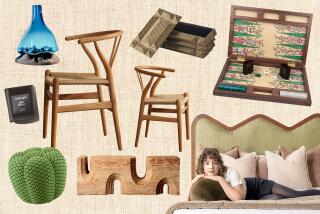FURNITURE : Putting the Pieces Together With Style
- Share via
The sleek, free-form desk and English secretary with carved finials, pendant pulls and ogee bracket feet are worlds apart in appearances. But they have a common bond in construction. Both are mass-produced and shipped ready for the consumer to assemble.
Ready-to-assemble pieces--known as RTA--originally were marketed not for looks but for price. High-end furniture companies needn’t worry, but RTA furniture is gaining style and ground.
“At least 20% of American households purchased ready-to-assemble furniture within the last year, based on two independent market research surveys and our own sales data,” says Kevin Sauder of Archbold, Ohio. Sauder is vice president of Sauder Woodworking, a company in the northwestern corner of the state that is one of the largest producers of RTA furniture.
Industry retail sales are expected to top $2 billion by 1996, about double those of 1989, according to Sauder and Wheat First Securities investment firm. A good deal of the new growth is expected in pieces that look pre-built or that offer special features such as custom storage.
“No segment of the furniture business appears to turn out new items faster,” according to Furniture Today, a trade journal in High Point, N.C. Among items noted were a roll-top desk that stows a complete computer system, office and home entertainment units assembled with Velcro, and bedroom pieces with solid wood tops and roomy drawers.
Office superstores, catalogues and discounters are the main outlets for RTA, but specialty retailers loom. Last fall, Gary Chrisinger and two partners opened Home Concept in Appleton, Wis. The stock is RTA furniture for home office, living room and bedroom, plus lighting and accessories. Chrisinger says the furniture is priced one-quarter to one-third below most assembled pieces.
“As far as the design of ready-to-assemble furniture goes,” he adds, “I think that we are at the beginning--on step two of a 10-step process.”
A major boost to the styling possibilities of RTA furniture is sophisticated machinery that permits shaped, banded edges and curved parts. Another is new types of fasteners. Gone are the big bolts that were a dead giveaway that you had a hand in the assembly. Now, fasteners are at the least unobtrusive and at best hidden. A number of pieces come with traditional hardware too.
In addition, laminates on top of particleboard and fiberboard can imitate most surfaces: wood veneers, faux marble or granite, black lacquer or a paint box full of colors and patterns. Although you can’t carve this engineered wood, embossing machines can make surface indentations and designs.
How easy is all of this to assemble? Well, Sauder gave an RTA kit and instructions to a class of sixth-graders. The kids mastered the assignment without difficulty.
Although RTA furniture is not new, advances in manufacturing and technology have led to plant expansions--and designs beyond the utilitarian.
Plants are highly automated, with panels passing on rollers through various processes from sanding and laminating to cutting. Finally, the parts are gathered, inspected and packaged with instructions for assembly.
In Europe, where modern is king, the simple lines long associated with RTA furniture fit right in. But many Americans still prefer traditional styling.
“We’re in competition with Bassett and Broyhill,” Sauder says, referring to two large American makers of traditional-style furniture.
Sauder is adding pieces to the 18th-Century “cherry” furniture, more country-style “washed pine” pieces and children’s furniture in bright colors. Last fall, the company introduced mission-style tables and storage pieces.
While style possibilities are limitless, tooling costs keep them in check. Quantities must be high, therefore designs must have mass appeal.
“I could design something that I could sell dozens,” Sauder says, “but we measure a success in thousands.”
More to Read
Inside the business of entertainment
The Wide Shot brings you news, analysis and insights on everything from streaming wars to production — and what it all means for the future.
You may occasionally receive promotional content from the Los Angeles Times.










